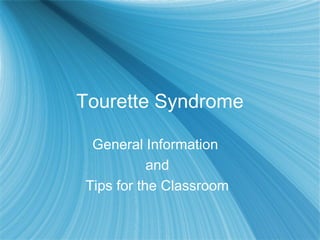
Tourette syndrome
- 1. Tourette Syndrome General Information and Tips for the Classroom
- 2. What is it? Tourette Syndrome (TS) is a “neurological disorder characterized by tics.” (Nielsen, p. 175) A tic is an “involuntary, sudden, rapid, recurrent, nonrhythmic, stereotyped motor movement or vocalization. It is experienced as irresistible, but can be suppressed for varying lengths of time.” (Nielsen, p. 175)
- 3. Types of Tics Motor tics can include eye blinking, nose twitching, lip smacking, leg jerking or flapping, hitting self or others, clapping, pinching, kissing, squatting, or any other combinations of movements done repeatedly. (Nielsen, p.178) Vocal tics can include grunts, sniffs, snorts, screams, stammers, laughs, guttural sounds, clicking, or even fully formed understandable words. (Nielsen, p. 178) Other vocal characteristics may include repeating the speech of others, repeating self, or involuntary speech of obscenities or socially taboo phrases. (Nielsen, p. 178) Contrary to the popular portrayal of TS, less than 1/3 of clinic patients involuntarily shouts obscenities. (Robertson, p. 427)
- 4. History The first case was documented in 1825. (Robertson, p. 426) Gilles de la Tourette was a French neurologist who first described it in 1885 with its current definition revolving around muscle tics. (Robertson, p. 426)
- 5. Prevalence It is estimated that 100,000 Americans have been diagnosed with Tourette Syndrome, and three times as many males as females are affected. (Neilsen, p. 176) In Special Education classrooms, as many as 12% of students have been diagnosed with Tourette Syndrome, and up to 28% have been characterized as having some sort of tics. (Robertson, p. 426)
- 6. Connection with Other Disabilities Individuals with TS usually also have other disabilities or symptoms of other disabilities. (Nielsen, p. 178) These most commonly include obsessive compulsive behaviors, Attention Deficit/Hyperactive Disorder (ADHD), anxiety, and depression (Robertson, p. 429-431)
- 7. Diagnosis In order to be diagnosed with Tourette Syndrome, an individual must meet these 5 requirements. (Nielsen, p. 177) Both motor and vocal tics have been present at some time (not necessarily concurrently) Tics occur multiple times per day throughout a period of one year. The disturbance causes marked distress in social, or occupational functioning. The onset is before age 18. The disturbance is not due to direct bodily effects of the use of a substance or a general medical condition.
- 8. Treatment Thus far, treatment is purely symptomatic, and there is no known cure for TS. Tics are believed to be caused by problems with neurotransmitters in the brain, so dopamine receptor blockers are sometimes used to try and alleviate them. These blockers can cause severe side effects, and there is some research to see if tics can be treated using magnesium and vitamin B6 supplements, which are safer than stronger drugs. Trials among children have been rare, due to necessary legal protection for minors. More trials, especially among children, are needed to verify the usefulness of this addition. (Garcia-Lopez et. al, p. 2-9)
- 9. Classroom Strategies First and foremost, what must be understood is that tics displayed by students are not voluntary or an attempt to take control from the teacher. Keeping this in mind, tics must be approached differently from other classroom disruptions. This is mainly because encouraging a child to suppress his or her tics will often only have the opposite effect. (“Ask TSA”)
- 10. Classroom Strategies, cont. It is important that other students in the class understand TS and know why the student makes the noises he/she does. The tics will be less disruptive when they’re better understood, and more easily ignored by the rest of the class. The best way to approach these tics as a teacher, unless they become especially disruptive, is to ignore them completely. Continually singling the child out will result in lowered self-image and harm the student’s learning environment. (“Ask TSA”)
- 11. Tic Management Strategies Tics are often brought on by stressful environments, and can be alleviated by allowing the student to take frequent breaks. Sending the child on an errand to the school office or library, or even just allowing trips to get a drink of water or use the restroom can be enough to help the child relax. In assigning homework, particularly long-term assignments, the teacher should make sure the student is keenly aware of expectations and exactly when the assignment is due. (Nielsen, p. 179)
- 12. Tic Management Strategies, cont. Timed tests can also present a problem for students with TS, so it is always better to allow the student to work at his or her own pace. Setting aside a separate time for the student to take the test might work well to help the student be successful. Transition times between activities and classes can also be stressful, and allowing a student with TS to leave class a couple minutes early in order to reduce stress could also be a successful tactic. (Nielsen, p. 179)
- 13. Students with TS Tourette Syndrome is not a degenerative disease, and brain function is not affected. A student with TS may achieve just as highly as a student without TS. This allows the teacher to have the same high expectations for that student as all the other students in the classroom. These high expectations will help the child achieve highly.
- 14. References Garcia-Lopez, R., Perea-Milla, E., Garcia, C. R., Rivas-Ruiz, F., Romero-Gonzales, J., Moreno, J., Faus, V., Aguas, G. C., Diaz, J. C. R. (2009). New therapeutic approach to Tourette Syndrome in children based on a randomized placebo-controlled double-blind phase IV study of the effectiveness and safety of magnesium and vitamin B6. Trials, 10(16). doi:10.1186/1745-6215-10-16 Nielsen, L. B. (2009). Brief Reference of Student Disabilities… With Strategies for the Classroom. Thousand Oaks, California: Corwin Press. Robertson, M. M. (2000). Tourette Syndrome, Associated Conditions and the Complexities of Treatment. Brain, 123(3), 425-462. doi: 10.1093/brain/123.3.425 (2013) Ask TSA. Retrieved from http://www.tsa- usa.org/aeduc_advoc/education_q_and_a.htm